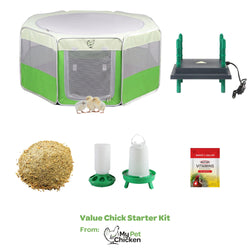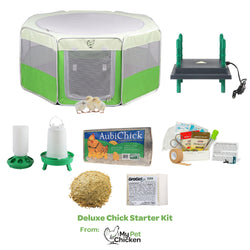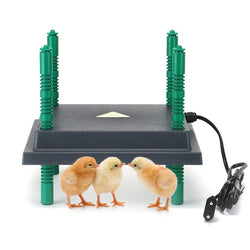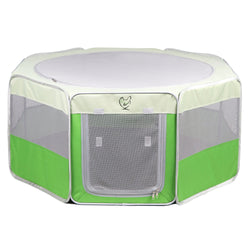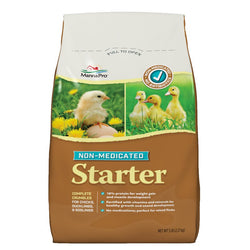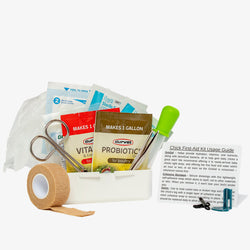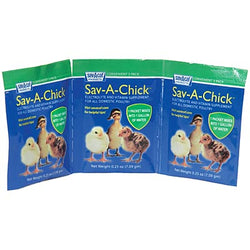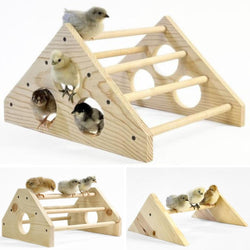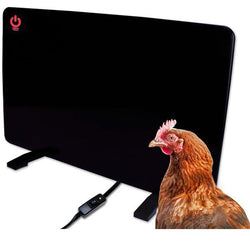All about Infectious Laryngotracheitis disease
Back to blog
"Laryngotracheitis" simply means inflammation of the larynx and trachea--in this case caused by a highly-contagious virus. The virus cannot be spread to humans, but can be spread from bird-to-bird very quickly. As with all diseases, you may need a vet's care to get a reliable diagnosis, but practicing good biosecurity, keeping your flock relatively stress-free, and sanitizing your coop and run area may help keep your flock from getting this virus and/or spreading it around. Read on to find out more...
Infectious Larygotracheitis
Also called
Avian Diphtheria, Laryngo, ILT
Prevalence
Common
Signs
General signs -
General signs of respiratory illness like swollen or watery/mucousy eyes, coughing, sneezing, wheezing, rattling breath, choking, whistling throat, spitting blood, blood around beak/mouth. You also may see other, general signs of illness, including lack of appetite, lethargy, huddling near heat source, and fluffed up feathers. Mortality runs at 50% or so for adult birds, but may be significantly higher with stress in the flock or acute infections... and may be significantly lower in mild strains.
Cardinal or diagnostic signs -
Post mortem: Trachea wholly or partially plugged with mucous.
Cause/s -
Gallid herpesvirus I (ILTV)
Communicability
Extraordinarily communicable. Can be spread bird-to-bird in the air. The virus only survives about 10 days off the bird, but can survive more than two months in coughed up mucous or in a carcass.
Communicability to humans
No, humans cannot be infected with this virus. (Diphtheria in humans is caused by a different virus.) However, you can carry the virus to your birds on shoes or equipment, so be sure to thoroughly wash and sanitize hands after handling birds or equipment, and be sure to sanitize equipment. Dispose of dead birds responsibly.
Incubation period
5 to 12 days
Latent
Yes. Chickens who recover will be asymptomatic carriers and spread the illness to other chickens (and also to pheasants). This is a reportable illness in some areas.
Endemic
Yes, common in some areas.
Home treatment and/or prevention
Prevention: There are vaccines, but it is not common to vaccinate chickens for this illness, because vaccinated birds can be carriers and shed the virus when stressed. Practice good biosecurity, especially if you show your birds at exhibitions. Keep your coop and run clean and dry. Sanitize your equipment, shoes, etc. Quarantine any birds showing signs of respiratory infection.
Treatment: None. Still, making sure the sick birds are not subject to other stressors can reduce mortality. For instance, make sure they have access to an area that is sufficiently warm (or cool). Electrolytes in water can help.
Veterinary care
Consult a vet or your local extension agent to get a firm diagnosis. If it is Laryngotracheitis, you'll want to take steps to sanitize your coop after the infection has passed, because any exudates coughed up by sick birds can house the virus for long periods of time.
Recovery
Most birds who recover will do so in two weeks or so. But recovered birds will be carriers of the disease, meaning that any nearby flocks will be in danger, and any birds you later introduce to your flock may get sick.
Other conditions, illnesses and/or diseases with similar signs:
Can be mistaken for other respiratory infections or conditions like Coryza, Roup, Wet Pox, Newcastle, Gapeworm.
Also consider browsing through this list of other chicken illnesses with respiratory symptoms.
Avian Diphtheria, Laryngo, ILT
Prevalence
Common
Signs
General signs -
General signs of respiratory illness like swollen or watery/mucousy eyes, coughing, sneezing, wheezing, rattling breath, choking, whistling throat, spitting blood, blood around beak/mouth. You also may see other, general signs of illness, including lack of appetite, lethargy, huddling near heat source, and fluffed up feathers. Mortality runs at 50% or so for adult birds, but may be significantly higher with stress in the flock or acute infections... and may be significantly lower in mild strains.
Cardinal or diagnostic signs -
Post mortem: Trachea wholly or partially plugged with mucous.
Cause/s -
Gallid herpesvirus I (ILTV)
Communicability
Extraordinarily communicable. Can be spread bird-to-bird in the air. The virus only survives about 10 days off the bird, but can survive more than two months in coughed up mucous or in a carcass.
Communicability to humans
No, humans cannot be infected with this virus. (Diphtheria in humans is caused by a different virus.) However, you can carry the virus to your birds on shoes or equipment, so be sure to thoroughly wash and sanitize hands after handling birds or equipment, and be sure to sanitize equipment. Dispose of dead birds responsibly.
Incubation period
5 to 12 days
Latent
Yes. Chickens who recover will be asymptomatic carriers and spread the illness to other chickens (and also to pheasants). This is a reportable illness in some areas.
Endemic
Yes, common in some areas.
Home treatment and/or prevention
Prevention: There are vaccines, but it is not common to vaccinate chickens for this illness, because vaccinated birds can be carriers and shed the virus when stressed. Practice good biosecurity, especially if you show your birds at exhibitions. Keep your coop and run clean and dry. Sanitize your equipment, shoes, etc. Quarantine any birds showing signs of respiratory infection.
Treatment: None. Still, making sure the sick birds are not subject to other stressors can reduce mortality. For instance, make sure they have access to an area that is sufficiently warm (or cool). Electrolytes in water can help.
Veterinary care
Consult a vet or your local extension agent to get a firm diagnosis. If it is Laryngotracheitis, you'll want to take steps to sanitize your coop after the infection has passed, because any exudates coughed up by sick birds can house the virus for long periods of time.
Recovery
Most birds who recover will do so in two weeks or so. But recovered birds will be carriers of the disease, meaning that any nearby flocks will be in danger, and any birds you later introduce to your flock may get sick.
Other conditions, illnesses and/or diseases with similar signs:
Can be mistaken for other respiratory infections or conditions like Coryza, Roup, Wet Pox, Newcastle, Gapeworm.
Also consider browsing through this list of other chicken illnesses with respiratory symptoms.

